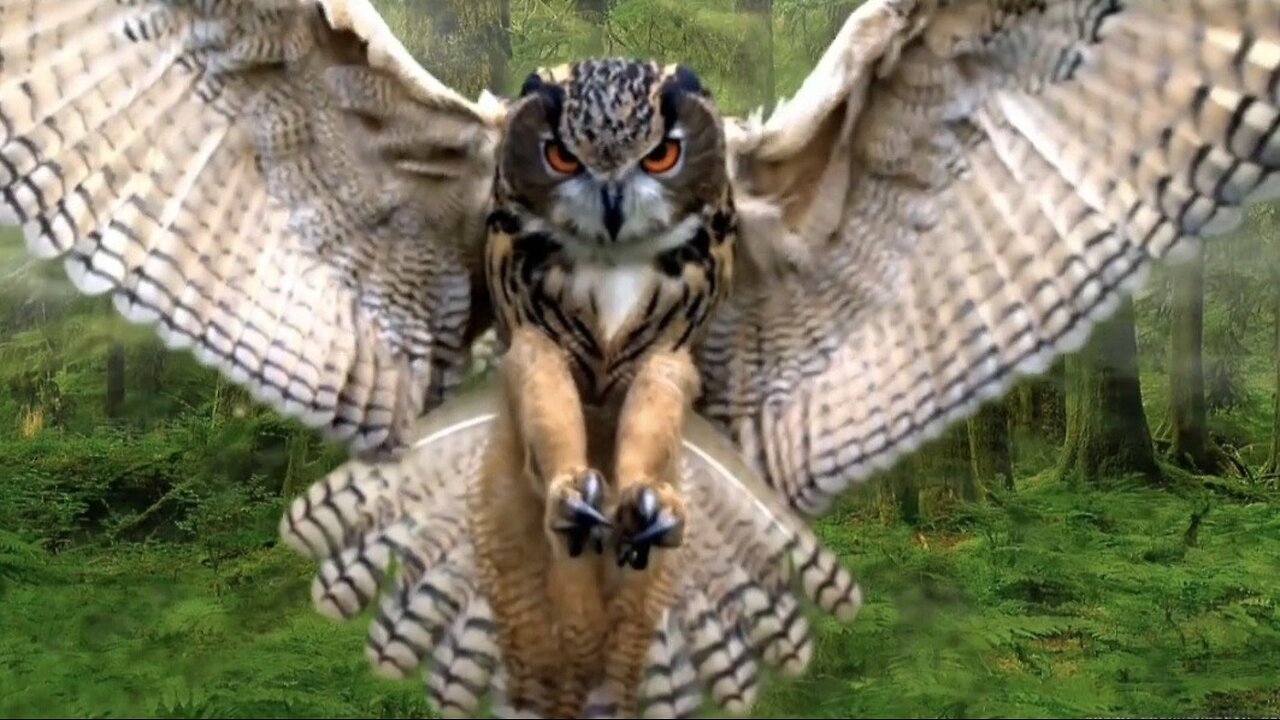Premium Only Content

"Owls: Masters of the Night Sky"
Owls are fascinating and diverse birds known for their distinct appearance, nocturnal habits, and silent flight. They belong to the order Strigiformes, which includes over 200 species classified into two main families: the Strigidae (typical owls) and Tytonidae (barn owls). Owls are found in nearly every habitat across the globe, from dense forests to deserts and tundra regions.
Physical Characteristics
Owls have a unique set of physical traits that make them efficient nocturnal hunters. Some of their key characteristics include:
1. Large Eyes: Owls have large, forward-facing eyes that provide binocular vision, giving them excellent depth perception. Their eyes are fixed in their sockets, so they compensate by rotating their heads up to 270 degrees to look around.
2. Facial Discs: Many owls have a distinctive facial structure known as a facial disc. This disc helps funnel sound to their ears, enhancing their ability to locate prey through hearing. Barn owls have the most pronounced facial discs.
3. Feathers and Silent Flight: Owls are known for their ability to fly silently. This is due to their specialized feathers, which are soft and serrated, reducing turbulence and noise. This allows them to sneak up on prey undetected.
4. Sharp Talons and Beaks: Their powerful talons and hooked beaks are designed for catching and tearing apart prey, making them excellent hunters.
5. Camouflage: Many owl species have feather patterns that allow them to blend into their environment, such as the bark of trees or foliage, which helps them avoid predators during the day.
Behavior and Hunting
Owls are primarily nocturnal, though some species, like the Northern Hawk Owl and the Burrowing Owl, are diurnal or crepuscular (active during dawn and dusk). They are carnivorous and feed on a variety of prey, including small mammals like rodents, insects, and birds. Larger species may hunt rabbits, hares, or even other birds of prey.
Their hunting strategy typically involves perching quietly and using their exceptional hearing and vision to detect movement. Once prey is located, owls swoop down silently to catch it with their sharp talons. They often swallow their prey whole and later regurgitate the indigestible parts, such as bones and fur, in the form of pellets.
Hearing and Vision
Owls possess remarkable hearing abilities, with some species, like the barn owl, capable of detecting prey by sound alone, even in total darkness. Their asymmetrically placed ears allow them to pinpoint the exact location of sounds, enhancing their hunting efficiency. Their large eyes, adapted for low-light conditions, contain more rod cells than cone cells, making them extremely sensitive to dim light.
Species Diversity
Owls vary significantly in size and habitat. Some notable species include:
1. Barn Owl (Tyto alba): Known for its heart-shaped face and pale plumage, the barn owl is widespread across the globe.
2. Great Horned Owl (Bubo virginianus): This large owl is native to the Americas and is known for its "horns" or tufts of feathers on its head.
3. Snowy Owl (Bubo scandiacus): A striking white owl that inhabits the Arctic tundra, the snowy owl is known for being active during the day in its northern habitat.
4. Elf Owl (Micrathene whitneyi): One of the smallest owls, found in the deserts of North America. It mainly feeds on insects.
5. Eurasian Eagle Owl (Bubo bubo): One of the largest owl species, found across Europe and Asia, this owl preys on mammals and other birds.
Habitat and Distribution
Owls are highly adaptable and can be found on every continent except Antarctica. They inhabit a wide variety of environments, including forests, grasslands, deserts, and urban areas. Each species tends to have specific habitat preferences. For example:
Forest owls: Species like the Barred Owl prefer dense woods, where they can easily find cover.
Open field owls: Owls such as the Short-eared Owl are often found in grasslands or agricultural fields.
Desert owls: Species like the Burrowing Owl are adapted to arid regions and even nest in burrows in the ground.
Symbolism and Cultural Significance
Owls have long been associated with mystery, wisdom, and death in various cultures. In Greek mythology, the owl was a symbol of Athena
-
 LIVE
LIVE
SpartakusLIVE
2 hours agoThe HUGEST Brain (not forehead) delivers Saturday SPARTOONS || Variety Later - Shadow of Mordor
6,631 watching -
 LIVE
LIVE
Rallied
2 hours ago $0.69 earnedSolo Challenges ALL DAY
118 watching -

Exploring With Nug
22 hours agoMassive Thunderstorm Hits During Search for Missing Georgia Woman!
498 -
 LIVE
LIVE
Sgt Wilky Plays
2 minutes agoRumble Gaming Bad Company Presents WARZONEPALOOZA
16 watching -
![Devin Nunes - Devin Nunes Reveals The Document The [DS] Was Looking For Was Hidden,Truth Is Coming](https://1a-1791.com/video/fww1/20/s8/1/-/e/L/d/-eLdz.0kob-small-Devin-Nunes-Devin-Nunes-Rev.jpg) 1:17:44
1:17:44
X22 Report
6 hours agoDevin Nunes - Devin Nunes Reveals The Document The [DS] Was Looking For Was Hidden,Truth Is Coming
56.6K70 -
 LIVE
LIVE
GritsGG
7 hours agoRumble Customs! 3515 Ws! 🫡!
206 watching -
 LIVE
LIVE
CassaiyanGaming
2 hours agoWARZONE PALOOZA - Rebirth with Cassaiyan, HannibalLecter, and DudeBroDude
76 watching -
 4:13:38
4:13:38
Akademiks
4 hours agoWar in RAT-LANTA. Young Thug vs Gunna vs Ralo vs YSL MONDO. Who Will Le Bebe Pick. FINAL CRASHOUT!
128K4 -
 21:55
21:55
MYLUNCHBREAK CHANNEL PAGE
1 day agoFault Lines are GATES - Pt 3
13.7K6 -

Sgt Wilky Plays
3 hours agoRumble Gaming Bad Company Presents WARZONEPALOOZA
8.22K